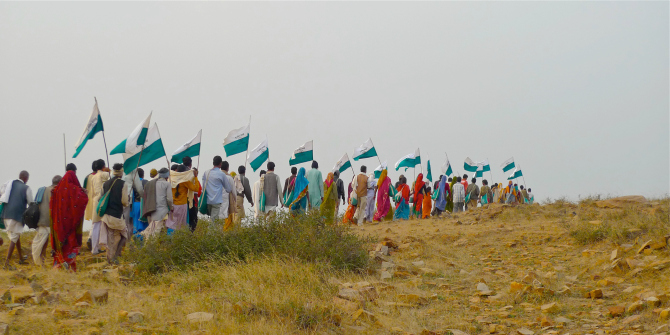
In conflict zones around the world, the phenomenon of foreign insurgents fighting on behalf of local rebel groups is a common occurrence. In Foreign Fighters, David Malet examines how insurgencies recruit individuals from abroad who would seem to have no direct connection to a distant war. Remarkably, the same recruiting strategies have been employed successfully in many foreign fighter cases, regardless of the particular circumstances of a conflict. This study undoubtedly offers important insights for policymakers, military strategists and IR scholars alike, writes Ilana Rothkopf.
Foreign Fighters: Transnational Identity in Civil Conflicts. David Malet. Oxford University Press. April 2013.
The United States Department of Counter Insurgency (COIN) Guide states that insurgency “can and will flourish in the modern environment,” and notes, “contemporary insurgencies are often supported or driven by transnational networks.” In light of the insurgencies in Iraq, Afghanistan, and the present civil conflict in Syria, insurgency and counterinsurgency necessarily factor into most modern military strategies. In this timely and insightful study, Foreign Fighters: Transnational Identity in Civil Conflicts, the University of Melbourne’s David Malet examines how organizations and movements recruit foreign citizens to engage in local insurgencies and civil conflicts.
Malet identifies an important shortcoming in the existing literature on transnational insurgencies, most of which focuses only on Islamic networks and the American involvement in Iraq. Historically, Malet asserts, the recruitment of foreign fighters has hardly limited itself to Muslims or to Islamic ideology, though it has only recently garnered mainstream attention. He thus examines a variety of civil conflicts and their participants to determine how insurgencies mobilize networks and employ identities. He utilizes both an empirical evaluation of foreign (non-state) participation in civil conflicts and in-depth historical case studies to demonstrate how recruiters frame local insurgencies to attract international fighters. His analysis indicates that the majority (though not all) of transnational insurgencies draw on the salient transnational identities of the day: Islamic networks at present, Communist groups in the early 20th century, anarchists in the late 19th in what he labels a “period effect” (p.205). Moreover, Malet’s case studies – the Texas Revolution, the Spanish Civil War, the Israeli War of Independence, and Afghanistan – illustrate that conflict-framing and recruitment methods are similar across conflicts.
The first chapter of this book considers various theoretical approaches to the study of recruitment for civil conflicts, including the role of transnational group identities, greed and grievance, and message framing. Here Malet draws heavily on Ole Waever and Barry Buzan’s work in security studies, and emphasizes the intersubjective processes of both securitization and identity formation.
The second chapter, “A History of Foreign Fighters” serves to explain the author’s dataset and the typology he develops to categorize foreign fighters. Malet codes the foreign fighters as “diasporans,” “liberationists”, “encroachers”, and “true believers.” Each type of foreign fighter describes some combination of coethnic or non-coethnic involvement in either ethnic or non-ethnic conflict. Notably, this chapter includes helpful visuals for Malet’s empirical data. This data shows both that foreign fighters have been recruited in more civil conflicts over time and that they are more likely to be recruited in nonethnic civil conflicts than in ethnic ones. As noted above, Malet subsequently supports his empirical findings with detailed case studies, which provide both broader historical analyses and anecdotal evidence to support his claim. Each case study provides some historical background for readers unfamiliar with that particular conflict, and addresses recruiters’ messages, target audiences, and exploitation of networks and identities.
In each case chapter, the author provides a “functionalist perspective” on the similarities and differences between civil conflicts, and concurrently warns against over-simplification and the utilization of inaccurate historical analogies. Malet’s first case study, The 1835-1836 Texas Revolution exemplifies a transnational insurgency involving co-ethnics (Americans and Anglophone Texians in pre-American Texas) in a non-ethnic civil conflict between Texas and the government of Mexico. Of particular interest is his observation of a shift in the conflict’s framing over time. While the Texian leadership initially framed its fight within the context of the broader Mexican civil war as a Western liberal’s grievance against an oppressive central government, it eventually shifted the message to a call for the defence of fellow Anglo-Americans under foreign rule. Malet noted such shifts in his other cases as well, all of which emphasised aspects of its target audience’s identities.

In the case of the Israeli War of Independence, Malet highlights the use of Jewish institutions such as the Jewish Agency and local community organizations to recruit volunteers to the Haganah (the primary pre-state military group). These groups targeted young men with specialized military skills from the Second World War, and drew on the very recent memory of the Holocaust to frame the conflict as a threat to world Jewry.
However, Malet does not fail to consider other non-ideological explanations for participation, and includes the sizeable contingent of non-Jewish participants in his analysis. This case also delves into the actual effectiveness of foreign volunteers in practice. Foreign units were also constrained by the operational challenges of extreme linguistic diversity and the “persistence of nationalism” (p.152) in spite of ideological ties. Such challenges manifested themselves similarly in the case of Afghanistan, where few Mujahidin spoke any local languages, and class divided wealthy Gulf Arabs from other volunteers.
Malet’s choice of case studies excellently illustrates his primary hypotheses that recruitment strategies remain consistent across time and are often framed as a threat to some transnational community. He carefully acknowledges the historical complexities and unique features of each case and relates the cases to one another where applicable throughout. Malet best ties his historical study to the present day with a short presentation of policy recommendations for states that engage in counterinsurgency operations. One such suggestion, which highlights avenues to the prevention of recruitment as an alternative to maintaining a high force profile in conflict zones, might be particularly appealing to governments seeking long longer term, cost-effective counterinsurgency strategies. This study undoubtedly offers important insights for policymakers, military strategists and scholars alike.
—————————————
Ilana Rothkopf completed an MSc in International Relations at the LSE in 2012, and holds an undergraduate degree in Political Science and Middle East studies from McGill University. Her research interests include foreign policy analysis, religion and international relations, political identity and the Middle East. Read more reviews by Ilana.






1 Comments